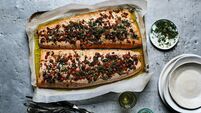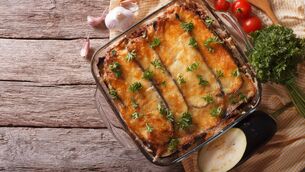Darina Allen: Shellfish and custard tarts — create a taste of Portugal at home

Those of you who pop over to Faro from time to time will be familiar with the spanking-fresh seafood on the Algarve but I’d only been to Portugal once before — a little foray over the border from Spain for a couple of hours so my knowledge was limited. It’s been a wonderful adventure.
We rented a little house in the old town of Olhão, a little fishing port not far from Faro, with some friends who also love to cook. We filled our baskets at the markets with local food and vegetables, bunches of purslane, verbena and coriander.
The redbrick fish market close to the seafront had a mesmerising selection of fish and shellfish: octopus, cuttlefish, clams, tiny conquilhas, mussels, razor clams, shrimps, and gorgeous silver scabbard fish. And Corvina — new to me — gurnard, sole, sea bass, beautiful little anchovies, whole or already gutted, ready to be pickled or fried, and, of course, mounds of fresh sardines.
Olhão was the centre of the sardine canning industry in Portugal and was famous for quality. Sadly, since the mid 1970s the action has moved to Morocco so the seaside town is now almost fully dependent on tourism.
Umpteen sandbanks appear and disappear with the tides. We visited several tiny islands off the coast, Coulatra, Isla de Cabanas, Armona. One day we took a boat and a picnic over to Ilsa Deserta, an idyllic desert island where we collected beautiful seashells and swam in the crystal clear waters.
At low tide, one can shuffle through the golden sand on all the local beaches and collect tiny conquilhas between one’s toes. Local fishers harvest clams, oysters and mussels as they have done for generations and take them home or sell them at the local fish market.
Twenty kilometres further along the coast in Tavira, I visited the salinas where the most exquisite flor da sal is harvested in the same time-honoured way that it has been for hundreds of years and surprise, surprise, there’s an Irish connection: Rui Simeao, the 86-year-old owner who lived through the end of the Second World War told me proudly that an Irishman called Anthony Creswell uses Tavira Flor da Sal for his multi-award-winning Ummera smoked salmon —a small world.
On Saturday, local farmers and their wives pour into the Olhão Market and set up stalls along the water's edge to sell their homegrown fruit and vegetables. Lots of beautifully ripe green and purple figs and many intriguing products made from the dried fruit. Little rolls and tiny cakes sweetly decorated with slivered locally-grown almonds. Beekeepers were out in force with their new season's honey: orange blossom, carob, rosemary, and little wedges of honeycomb. Another stall sold dried beans and lentils and both barley and wheat to grind at home for beer and bread-making.
I bought a verbena plant from a lady on a flower stand and queued for piping hot, crisp golden churros tossed in cinnamon sugar.
The white peaches were at their best too as were the huge juicy heritage tomatoes. One old lady was selling sweet potato greens and another, long strands of multi-coloured chilli peppers, some mild, others like scud missiles — a kind of Russian roulette.
We were so torn between cooking in our little house and eating in local restaurants and cafes. We grilled sardines over charcoal on the little barbeque in the courtyard; steamed open conquilhas with slivered garlic, chilli and coriander; ate mussels with Portuguese spinach; and made escabeche from the leftovers. Coriander is a favourite herb in Portugal, much more widely used than parsley.
Breakfast was a feast of fresh fruit, local cheese, honey and bread from the little bakery a few cobbled streets away. I also loved the pork with bay leaves and clams which I ordered twice at Sabores de Rio in the main square. I also loved riso con Lingueirão (razor clam rice) and love the sound of riso e pato — rice with duck. Many of these dishes are easy to reproduce at home. Make a trip to the fish stalls in the English Market in Cork, Ballycotton Seafood or your local fish shop. I use leftover roast duck for the riso e pato and have a feeling it will become a favourite.
There were lots of sweet eggy desserts but my favourite by far are pastéis de nata — the little flaky custard tarts dusted with a sprinkling of cinnamon.
Mussels with Saffron and Spinach
This is a beautiful dish with golden creamy sauce and bright green spinach leaves contrasting wonderfully with the black and orange of the mussels

Servings
4Preparation Time
10 minsCooking Time
10 minsTotal Time
20 minsCourse
MainIngredients
150g (5oz) spinach
extra virgin olive oil
4 tbsp dry white wine
2 sweet white onions, finely chopped
4 bay leaves
1 celery stick, finely chopped (optional)
a few sprigs of thyme
10 black peppercorns
1kg (2 ¼lb) mussels, cleaned and debearded
1 tablespoon unsalted butter
2 pinches of saffron strands
250g (9oz) crème fraîche
salt and freshly-ground black pepper
Method
- Wash the spinach, drain and then wilt it in a pan with a little olive oil. Don’t overcook it. Set aside.
Pour the wine into a large heavy-based pan with a tight-fitting lid. Add the onions, bay leaves, celery (if using), thyme and peppercorns and bring to a simmer.
Now tip in the mussels and cover the pan, keeping it over a low heat. Shake the pan now and then to distribute the shellfish. Check to see that the mussels have opened and, when they are all open, tip the lot into a colander set over a bowl to catch the stock. Remove the flesh from some of the mussels and discard these shells. Discard any mussels that have refused to open.
Wipe the pan and return it to the heat. Melt the butter and add the saffron, crème fraiche and the mussel liquor. Check for seasoning and add freshly ground black pepper. It’s just possible you will also need salt, but mussel stock is usually salted enough. Bring to the boil and simmer for a couple of minutes, then return the spinach and the mussels. Cook for a minute to warm the mussels through, then serve immediately in warmed bowls with crusty bread.
This recipe comes from Sam and Jeannie Chesterton’s The Buenvino Cookbook.
Portuguese steamed clams with Coriander
Quick easy and extremely delicious

Servings
4Preparation Time
10 minsCooking Time
10 minsTotal Time
20 minsCourse
MainIngredients
1kg clams
3 tbsp extra virgin olive oil
6 garlic cloves, roughly chopped
2 tbsp dry white wine
squeeze of freshly-squeezed lemon juice
freshly-ground black pepper
A handful of coriander, chopped
Method
Wash the clams in several changes of cold water, discard any with damaged or broken shells.
Heat the extra virgin olive oil in a wide sauté pan, add the garlic and cook for 4-5 minutes on a medium heat. Add the white wine and a generous squeeze of lemon juice, bring to the boil for 2-3 minutes and freshly-ground pepper.
Add the roughly chopped coriander and clams. Cover and allow to steam for 4-5 minutes or until the clams pop open. Turn into a serving dish, scatter with a little more coriander. Serve with good crusty bread to mop up the juices.
Custard tarts
This is our recipe for Pastéis de Nata, the famous Portuguese Custard tarts. We use homemade puff pastry to make these delicious tarts, they make a much more complicated pastry

Servings
24Preparation Time
20 minsCooking Time
30 minsTotal Time
50 minsCourse
BakingIngredients
1 large egg
2 egg yolks
115g (4oz) golden caster sugar
2 tablespoons cornflour
400ml (14fl oz) whole milk
zest from 1 lemon or 2 teaspoons of vanilla extract
900g (2lb) puff pastry
Method
Lightly grease 2 x 12 muffin tins.
Preheat the oven to 230°C/450°F/Gas Mark 8.
Put the egg, yolks, sugar and cornflour in a saucepan and whisk, gradually add the milk and lemon zest if using and whisk until smooth.
Cook on a medium heat and stirring constantly with a whisk until the mixture thickens and comes to the boil, continue to cook for 2 minutes. Remove the saucepan from the heat, stir in the vanilla extract if using.
Transfer to a Pyrex bowl, allow to cool. Cover with parchment paper to prevent a skin from forming — prick here and there to allow steam to escape.
Roll the chilled puff pastry into a 3mm (1/8 inch) thick sheet, stamp out 7.5cm (3 inch) discs. Press into the muffin tins.
Spoon a generous dessertspoon of the cool custard into each pastry case. Bake in the preheated oven for 16-20 minutes or golden on top. Allow to cool in the tins for 5 minutes then remove to a wire rack. Sprinkle with a little freshly ground cinnamon. Eat warm or at room temperature.
Check out Mexican Taqueria Food Truck on Camden Row in Dublin 8 run by 12-Week graduate Scott Holder. Los Chicanos taco menu is inspired by the flavours of Mexican cooking melded with the urban, funky and edgy street food culture of Los Angeles. Scott honed his love for Mexican food from Mexican chefs across the US and Mexico.
See @loschicanostacos on Instagram
A limited supply of Salt Marsh lamb from Calvey’s of Achill is now available. These animals graze on an extensive sandy bank area of Keel on particular seaside machair, salt marsh plants and herbs — this gives the lamb a unique flavour. Calvey’s On-Farm Abattoir Butchers has a special offer of 2 prepared lambs for €350 with free delivery nationwide.
achilllamb.ie or phone Gráinne on 098 43158
I’m a custard tart nerd. The most delicious custard tarts I’ve tasted in Ireland were at Hugo’s Bakery in Lahinch, worth a detour as in Comme á Lisbonne in the Marais in Paris – a tip for your next trip.






